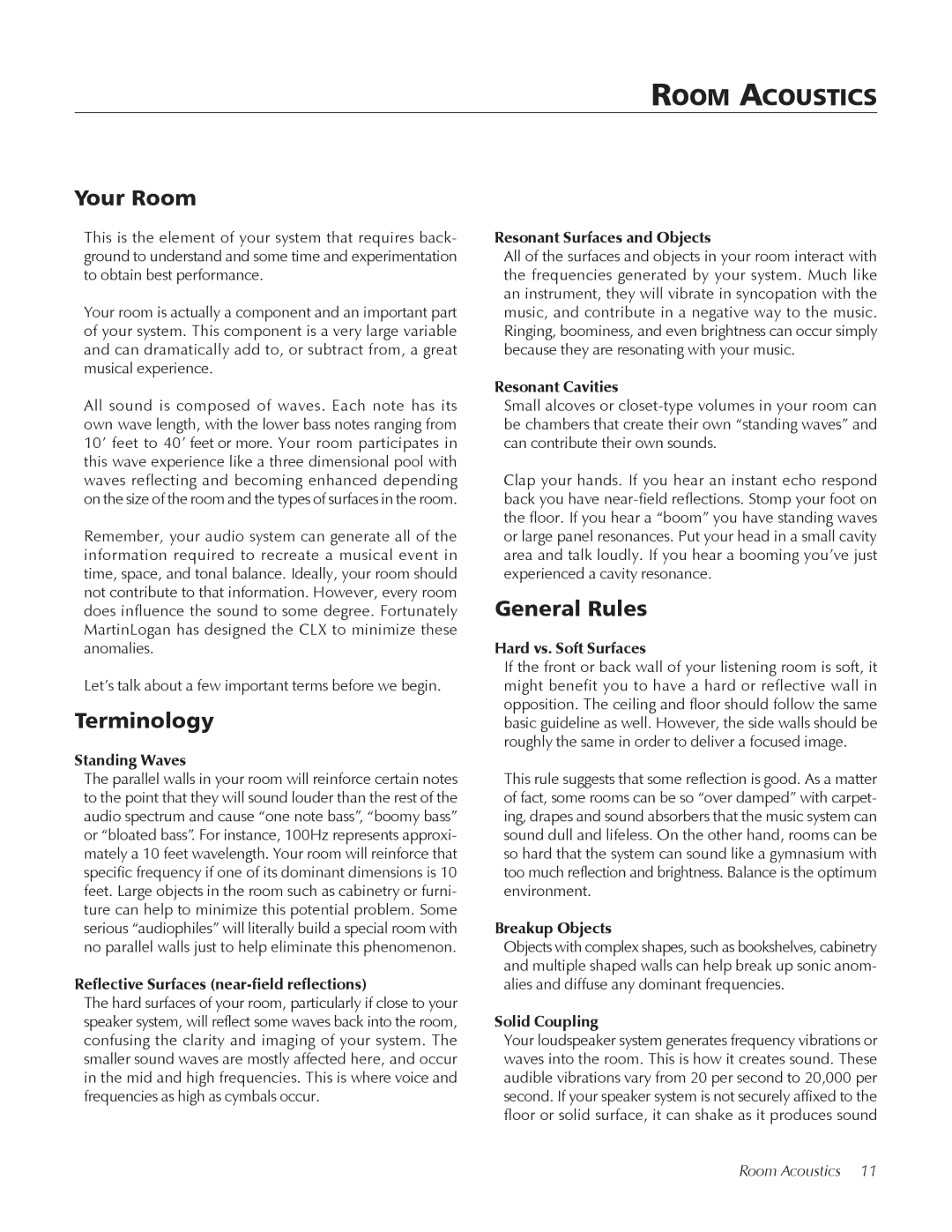Room Acoustics
Your Room
This is the element of your system that requires back- ground to understand and some time and experimentation to obtain best performance.
Your room is actually a component and an important part of your system. This component is a very large variable and can dramatically add to, or subtract from, a great musical experience.
All sound is composed of waves. Each note has its own wave length, with the lower bass notes ranging from 10’ feet to 40’ feet or more. Your room participates in this wave experience like a three dimensional pool with waves reflecting and becoming enhanced depending on the size of the room and the types of surfaces in the room.
Remember, your audio system can generate all of the information required to recreate a musical event in time, space, and tonal balance. Ideally, your room should not contribute to that information. However, every room does influence the sound to some degree. Fortunately MartinLogan has designed the CLX to minimize these anomalies.
Let’s talk about a few important terms before we begin.
Terminology
Standing .Waves
The parallel walls in your room will reinforce certain notes to the point that they will sound louder than the rest of the audio spectrum and cause “one note bass”, “boomy bass” or “bloated bass”. For instance, 100Hz represents approxi- mately a 10 feet wavelength. Your room will reinforce that specific frequency if one of its dominant dimensions is 10 feet. Large objects in the room such as cabinetry or furni- ture can help to minimize this potential problem. Some serious “audiophiles” will literally build a special room with no parallel walls just to help eliminate this phenomenon.
The hard surfaces of your room, particularly if close to your speaker system, will reflect some waves back into the room, confusing the clarity and imaging of your system. The smaller sound waves are mostly affected here, and occur in the mid and high frequencies. This is where voice and frequencies as high as cymbals occur.
Resonant .Surfaces .and .Objects
All of the surfaces and objects in your room interact with the frequencies generated by your system. Much like an instrument, they will vibrate in syncopation with the music, and contribute in a negative way to the music. Ringing, boominess, and even brightness can occur simply because they are resonating with your music.
Resonant .Cavities
Small alcoves or
Clap your hands. If you hear an instant echo respond back you have
General Rules
Hard .vs. .Soft .Surfaces
If the front or back wall of your listening room is soft, it might benefit you to have a hard or reflective wall in opposition. The ceiling and floor should follow the same basic guideline as well. However, the side walls should be roughly the same in order to deliver a focused image.
This rule suggests that some reflection is good. As a matter of fact, some rooms can be so “over damped” with carpet- ing, drapes and sound absorbers that the music system can sound dull and lifeless. On the other hand, rooms can be so hard that the system can sound like a gymnasium with too much reflection and brightness. Balance is the optimum environment.
Breakup .Objects
Objects with complex shapes, such as bookshelves, cabinetry and multiple shaped walls can help break up sonic anom- alies and diffuse any dominant frequencies.
Solid .Coupling
Your loudspeaker system generates frequency vibrations or waves into the room. This is how it creates sound. These audible vibrations vary from 20 per second to 20,000 per second. If your speaker system is not securely affixed to the floor or solid surface, it can shake as it produces sound
